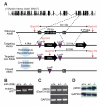A family of microRNAs encoded by myosin genes governs myosin expression and muscle performance
- PMID: 19922871
- PMCID: PMC2796371
- DOI: 10.1016/j.devcel.2009.10.013
A family of microRNAs encoded by myosin genes governs myosin expression and muscle performance
Abstract
Myosin is the primary regulator of muscle strength and contractility. Here we show that three myosin genes, Myh6, Myh7, and Myh7b, encode related intronic microRNAs (miRNAs), which, in turn, control muscle myosin content, myofiber identity, and muscle performance. Within the adult heart, the Myh6 gene, encoding a fast myosin, coexpresses miR-208a, which regulates the expression of two slow myosins and their intronic miRNAs, Myh7/miR-208b and Myh7b/miR-499, respectively. miR-208b and miR-499 play redundant roles in the specification of muscle fiber identity by activating slow and repressing fast myofiber gene programs. The actions of these miRNAs are mediated in part by a collection of transcriptional repressors of slow myofiber genes. These findings reveal that myosin genes not only encode the major contractile proteins of muscle, but act more broadly to influence muscle function by encoding a network of intronic miRNAs that control muscle gene expression and performance.
Figures








Similar articles
-
MicroRNA-208a is a regulator of cardiac hypertrophy and conduction in mice.J Clin Invest. 2009 Sep;119(9):2772-86. doi: 10.1172/JCI36154. Epub 2009 Aug 10. J Clin Invest. 2009. PMID: 19726871 Free PMC article.
-
Evolution and Distribution of Teleost myomiRNAs: Functionally Diversified myomiRs in Teleosts.Mar Biotechnol (NY). 2016 Jun;18(3):436-47. doi: 10.1007/s10126-016-9705-9. Epub 2016 Jun 4. Mar Biotechnol (NY). 2016. PMID: 27262998
-
Myh7b/miR-499 gene expression is transcriptionally regulated by MRFs and Eos.Nucleic Acids Res. 2012 Aug;40(15):7303-18. doi: 10.1093/nar/gks466. Epub 2012 May 25. Nucleic Acids Res. 2012. PMID: 22638570 Free PMC article.
-
The emerging role of miR-208a in the heart.DNA Cell Biol. 2013 Jan;32(1):8-12. doi: 10.1089/dna.2012.1787. Epub 2012 Nov 2. DNA Cell Biol. 2013. PMID: 23121236 Review.
-
A recurrent single-amino acid deletion (p.Glu500del) in the head domain of ß-cardiac myosin in two unrelated boys presenting with polyhydramnios, congenital axial stiffness and skeletal myopathy.Orphanet J Rare Dis. 2022 Jul 19;17(1):279. doi: 10.1186/s13023-022-02421-7. Orphanet J Rare Dis. 2022. PMID: 35854315 Free PMC article. Review.
Cited by
-
Perturbation of microRNAs in rat heart during chronic doxorubicin treatment.PLoS One. 2012;7(7):e40395. doi: 10.1371/journal.pone.0040395. Epub 2012 Jul 31. PLoS One. 2012. PMID: 22859947 Free PMC article.
-
Effects of Dietary Energy Sources on Post Mortem Glycolysis, Meat Quality and Muscle Fibre Type Transformation of Finishing Pigs.PLoS One. 2015 Jun 30;10(6):e0131958. doi: 10.1371/journal.pone.0131958. eCollection 2015. PLoS One. 2015. PMID: 26125946 Free PMC article.
-
Integrative Tissue-Specific Functional Annotations in the Human Genome Provide Novel Insights on Many Complex Traits and Improve Signal Prioritization in Genome Wide Association Studies.PLoS Genet. 2016 Apr 8;12(4):e1005947. doi: 10.1371/journal.pgen.1005947. eCollection 2016 Apr. PLoS Genet. 2016. PMID: 27058395 Free PMC article.
-
MicroRNAs: new players in heart failure.Mol Biol Rep. 2013 Mar;40(3):2663-70. doi: 10.1007/s11033-012-2352-y. Epub 2012 Dec 15. Mol Biol Rep. 2013. PMID: 23242657 Review.
-
Upregulation of Reg IV and Hgf mRNAs by Intermittent Hypoxia via Downregulation of microRNA-499 in Cardiomyocytes.Int J Mol Sci. 2022 Oct 17;23(20):12414. doi: 10.3390/ijms232012414. Int J Mol Sci. 2022. PMID: 36293268 Free PMC article.
References
-
- Adolph EA, Subramaniam A, Cserjesi P, Olson EN, Robbins J. Role of myocyte-specific enhancer-binding factor (MEF-2) in transcriptional regulation of the alpha-cardiac myosin heavy chain gene. J Biol Chem. 1993;268:5349–5352. - PubMed
-
- Azakie A, Fineman JR, He Y. Sp3 inhibits Sp1-mediated activation of the cardiac troponin T promoter and is downregulated during pathological cardiac hypertrophy in vivo. Am J Physiol Heart Circ Physiol. 2006;291:H600–611. - PubMed
-
- Baldwin KM, Haddad F. Effects of different activity and inactivity paradigms on myosin heavy chain gene expression in striated muscle. J Appl Physiol. 2001;90:345–357. - PubMed
-
- Bartel DP. MicroRNAs: genomics, biogenesis, mechanism, and function. Cell. 2004;116:281–297. - PubMed
Publication types
MeSH terms
Substances
Grants and funding
LinkOut - more resources
Full Text Sources
Other Literature Sources
Molecular Biology Databases
Miscellaneous

